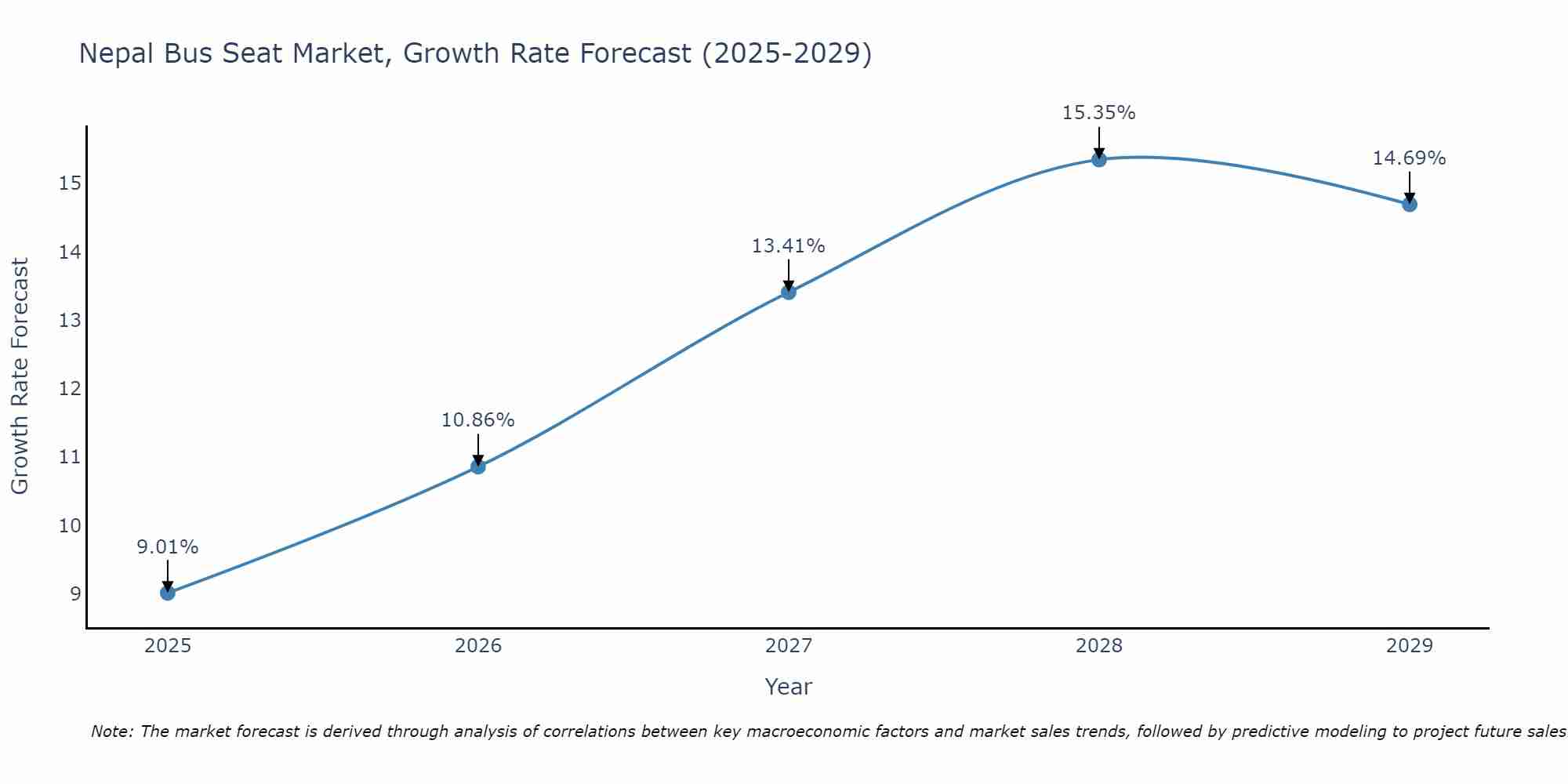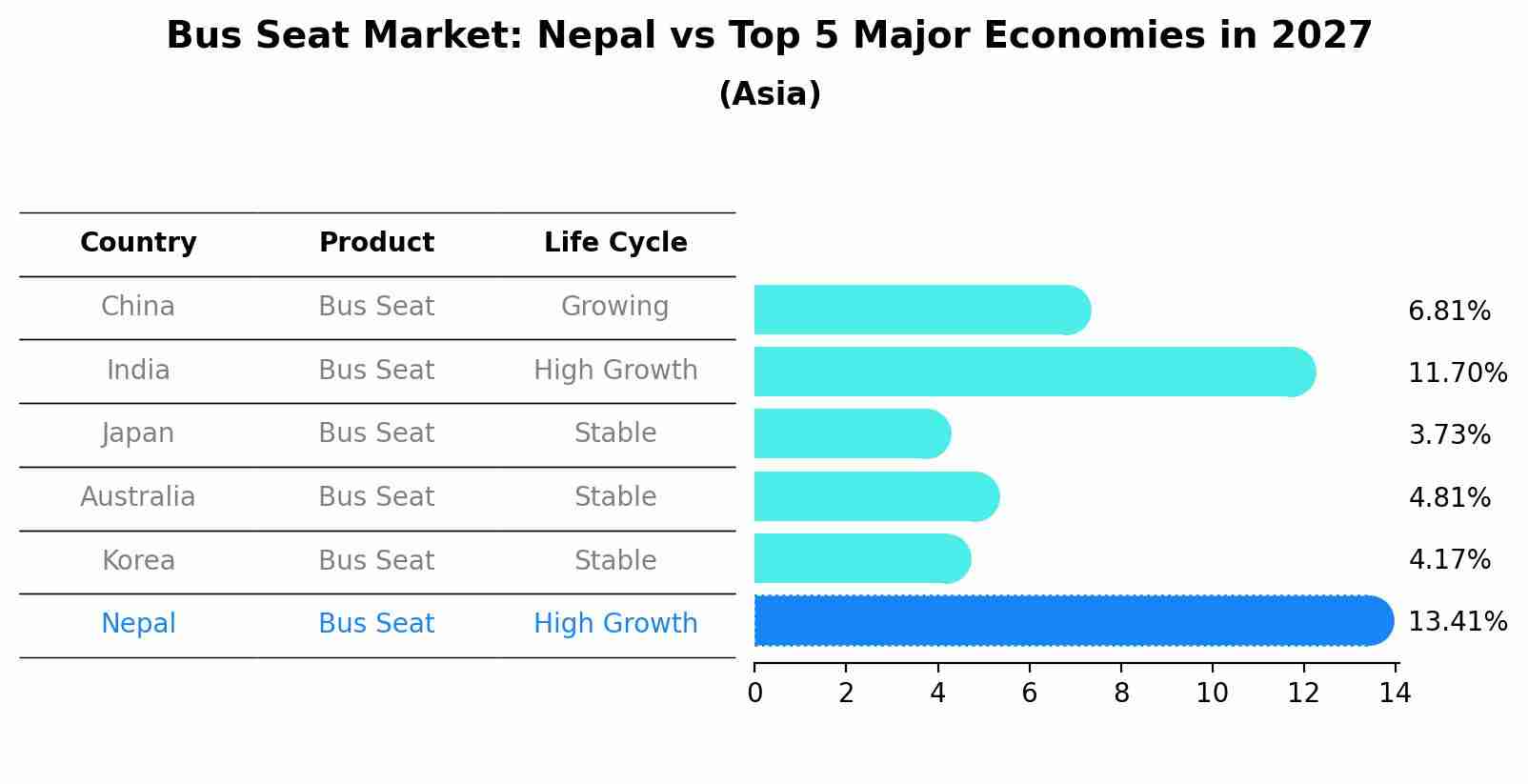Nepal Bus Seat Market (2025-2031) Outlook | Companies, Share, Analysis, Growth, Revenue, Value, Industry, Forecast, Size & Trends
| Product Code: ETC371076 | Publication Date: Aug 2022 | Updated Date: Jul 2025 | Product Type: Market Research Report | |
| Publisher: 6Wresearch | Author: Shubham Padhi | No. of Pages: 75 | No. of Figures: 35 | No. of Tables: 20 |
Nepal Bus Seat Market Size Growth Rate
The Nepal Bus Seat Market is projected to witness mixed growth rate patterns during 2025 to 2029. The growth rate begins at 9.01% in 2025, climbs to a high of 15.35% in 2028, and moderates to 14.69% by 2029.

Bus Seat Market: Nepal vs Top 5 Major Economies in 2027 (Asia)
By 2027, the Bus Seat market in Nepal is anticipated to reach a growth rate of 13.41%, as part of an increasingly competitive Asia region, where China remains at the forefront, supported by India, Japan, Australia and South Korea, driving innovations and market adoption across sectors.

Nepal Bus Seat Market Synopsis
The Nepal bus seat market is experiencing steady growth driven by increasing urbanization, expanding public transportation networks, and rising demand for comfortable and safe seating options. Key players in the market are focusing on product innovation to offer ergonomic designs, advanced safety features, and enhanced comfort for passengers. The market is also witnessing a shift towards eco-friendly materials and sustainable manufacturing practices to align with growing environmental concerns. With a growing emphasis on passenger experience and convenience, bus operators are increasingly investing in high-quality seating solutions to attract and retain customers. Overall, the Nepal bus seat market presents opportunities for manufacturers to cater to the evolving needs of the transportation sector and capitalize on the growing demand for reliable and stylish seating options.
Nepal Bus Seat Market Trends
The Nepal bus seat market is witnessing a shift towards more comfortable and ergonomic designs to enhance passenger comfort and safety. There is a growing demand for seats with features such as adjustable headrests, armrests, reclining options, and ample legroom. Additionally, there is an increasing focus on using sustainable and eco-friendly materials in seat production to align with environmental concerns. Bus operators are also investing in seats with improved durability and easy maintenance to reduce long-term operating costs. Overall, the trend in the Nepal bus seat market is towards offering a more pleasant and convenient travel experience for passengers while also addressing sustainability issues.
Nepal Bus Seat Market Challenges
In the Nepal bus seat market, several challenges are faced by manufacturers and suppliers. These include intense competition among market players leading to pricing pressures, limited technological advancements in terms of comfort and safety features compared to global standards, inconsistent quality control leading to issues with durability and reliability, and the impact of economic fluctuations on consumer purchasing power affecting overall demand for bus seats. Additionally, logistical challenges such as transportation and distribution difficulties in reaching remote areas within Nepal also pose obstacles for market players. Overall, addressing these challenges requires a strategic focus on innovation, quality improvement, cost-effective manufacturing processes, and efficient distribution networks to remain competitive in the Nepal bus seat market.
Nepal Bus Seat Market Investment Opportunities
The Nepal bus seat market presents several investment opportunities, driven by factors such as increasing urbanization, rising disposable incomes, and a growing tourism industry. Investing in the manufacturing and distribution of ergonomic and comfortable bus seats that cater to the needs of both local commuters and tourists could be lucrative. Additionally, there is a demand for innovative seating solutions that prioritize safety and durability, as well as customization options to suit different bus types and sizes. Collaborating with bus manufacturers and operators to provide high-quality, cost-effective seating solutions could also be a promising investment avenue. With the government`s focus on improving public transportation infrastructure, investing in the Nepal bus seat market holds potential for long-term growth and profitability.
Jordan Agar Market Government Policies
Government policies related to the Nepal Bus Seat Market focus on ensuring safety, comfort, and fair pricing for passengers. The Department of Transport Management regulates the maximum number of seats allowed in buses to prevent overcrowding and ensure passenger safety. Additionally, the government sets guidelines for the design and quality of bus seats to enhance comfort during long-distance travel. Price regulation policies aim to prevent price gouging and ensure fair pricing for passengers across different bus operators. The government also emphasizes the importance of accessibility for persons with disabilities by mandating the inclusion of designated seats for them in buses. Overall, these policies aim to create a competitive and consumer-friendly market environment in the Nepal bus seat industry.
Nepal Bus Seat Market Future Outlook
The future outlook for the Nepal bus seat market appears promising, driven by factors such as increasing urbanization, rising disposable incomes, and a growing tourism sector. As the country continues to develop its infrastructure and transportation networks, there is likely to be a higher demand for buses equipped with comfortable and durable seating options. Additionally, with a focus on improving passenger safety and comfort, bus operators may increasingly invest in upgrading and modernizing their fleets with high-quality seating solutions. Manufacturers in the bus seat market are expected to innovate and offer a range of seating options to cater to the evolving needs of both passengers and bus operators. Overall, the Nepal bus seat market is anticipated to witness steady growth in the coming years.
Key Highlights of the Report:
- Nepal Bus Seat Market Outlook
- Market Size of Nepal Bus Seat Market, 2024
- Forecast of Nepal Bus Seat Market, 2031
- Historical Data and Forecast of Nepal Bus Seat Revenues & Volume for the Period 2021 - 2031
- Nepal Bus Seat Market Trend Evolution
- Nepal Bus Seat Market Drivers and Challenges
- Nepal Bus Seat Price Trends
- Nepal Bus Seat Porter's Five Forces
- Nepal Bus Seat Industry Life Cycle
- Historical Data and Forecast of Nepal Bus Seat Market Revenues & Volume By Seat Type for the Period 2021 - 2031
- Historical Data and Forecast of Nepal Bus Seat Market Revenues & Volume By Standard for the Period 2021 - 2031
- Historical Data and Forecast of Nepal Bus Seat Market Revenues & Volume By Recliner for the Period 2021 - 2031
- Historical Data and Forecast of Nepal Bus Seat Market Revenues & Volume By Component Type for the Period 2021 - 2031
- Historical Data and Forecast of Nepal Bus Seat Market Revenues & Volume By Frame for the Period 2021 - 2031
- Historical Data and Forecast of Nepal Bus Seat Market Revenues & Volume By Upholstery for the Period 2021 - 2031
- Nepal Bus Seat Import Export Trade Statistics
- Market Opportunity Assessment By Seat Type
- Market Opportunity Assessment By Component Type
- Nepal Bus Seat Top Companies Market Share
- Nepal Bus Seat Competitive Benchmarking By Technical and Operational Parameters
- Nepal Bus Seat Company Profiles
- Nepal Bus Seat Key Strategic Recommendations
Frequently Asked Questions About the Market Study (FAQs):
- Single User License$ 1,995
- Department License$ 2,400
- Site License$ 3,120
- Global License$ 3,795
Search
Thought Leadership and Analyst Meet
Our Clients
Related Reports
- Afghanistan Apparel Market (2026-2032) | Growth, Outlook, Industry, Segmentation, Forecast, Size, Companies, Trends, Value, Share, Analysis & Revenue
- Canada Oil and Gas Market (2026-2032) | Share, Segmentation, Value, Industry, Trends, Forecast, Analysis, Size & Revenue, Growth, Competitive Landscape, Outlook, Companies
- Germany Breakfast Food Market (2026-2032) | Industry, Share, Growth, Size, Companies, Value, Analysis, Revenue, Trends, Forecast & Outlook
- Australia Briquette Market (2025-2031) | Growth, Size, Revenue, Forecast, Analysis, Trends, Value, Share, Industry & Companies
- Vietnam System Integrator Market (2025-2031) | Size, Companies, Analysis, Industry, Value, Forecast, Growth, Trends, Revenue & Share
- ASEAN and Thailand Brain Health Supplements Market (2025-2031) | Strategy, Consumer Insights, Analysis, Investment Trends, Opportunities, Growth, Size, Share, Industry, Revenue, Segments, Value, Segmentation, Supply, Forecast, Restraints, Outlook, Competition, Drivers, Trends, Demand, Pricing Analysis, Competitive, Strategic Insights, Companies, Challenges
- ASEAN Bearings Market (2025-2031) | Strategy, Consumer Insights, Analysis, Investment Trends, Opportunities, Growth, Size, Share, Industry, Revenue, Segments, Value, Segmentation, Supply, Forecast, Restraints, Outlook, Competition, Drivers, Trends, Demand, Pricing Analysis, Competitive, Strategic Insights, Companies, Challenges
- Europe Flooring Market (2025-2031) | Outlook, Share, Industry, Trends, Forecast, Companies, Revenue, Size, Analysis, Growth & Value
- Saudi Arabia Manlift Market (2025-2031) | Outlook, Size, Growth, Trends, Companies, Industry, Revenue, Value, Share, Forecast & Analysis
- Uganda Excavator, Crane, and Wheel Loaders Market (2025-2031) | Strategy, Consumer Insights, Analysis, Investment Trends, Opportunities, Growth, Size, Share, Industry, Revenue, Segments, Value, Segmentation, Supply, Forecast, Restraints, Outlook, Competition, Drivers, Trends, Demand, Pricing Analysis, Competitive, Strategic Insights, Companies, Challenges
Industry Events and Analyst Meet
Whitepaper
- Middle East & Africa Commercial Security Market Click here to view more.
- Middle East & Africa Fire Safety Systems & Equipment Market Click here to view more.
- GCC Drone Market Click here to view more.
- Middle East Lighting Fixture Market Click here to view more.
- GCC Physical & Perimeter Security Market Click here to view more.
6WResearch In News
- Doha a strategic location for EV manufacturing hub: IPA Qatar
- Demand for luxury TVs surging in the GCC, says Samsung
- Empowering Growth: The Thriving Journey of Bangladesh’s Cable Industry
- Demand for luxury TVs surging in the GCC, says Samsung
- Video call with a traditional healer? Once unthinkable, it’s now common in South Africa
- Intelligent Buildings To Smooth GCC’s Path To Net Zero


















